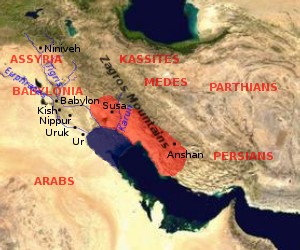사용자:배우는사람/문서:Anshan (Persia)

Anshan (틀:Lang-fa, modern Tall-i Malyan, northwest of Shiraz, in the Beyza / Ramjerd plain , in the province of Fars in the Zagros mountains , southwestern Iran, was one of the early capitals of Elam, from the 3rd millennium BC.
History
편집Before 1973, when it was identified as Tall-i Malyan,[1] Anshan had been assumed by scholars to be somewhere in the central Zagros mountain range.[2]
The Elamite city appears to have been quite ancient; it makes an appearance in the early Sumerian epic Enmerkar and the Lord of Aratta as being en route between Uruk and the legendary Aratta, supposedly around the time writing was developed. At various times, Anshan provided, in its own right, the source for a number of Elamite dynasties that sometimes competed for extent and influence with other prominent Elamite cities.
Manishtushu claimed to have subjugated Anshan, but as the Akkadian empire weakened under his successors, the native governor of Susa, Kutik-Inshushinak, a scion of the Awan dynasty, proclaimed his independence from Akkad and captured Anshan (some scholars have speculated that the name Awan is an alternate form of Anshan). Following this, Gudea of Lagash claimed to have subjugated Anshan, and the Neo-Sumerian rulers Shulgi and Shu-Sin of Ur are said to have maintained their own governors over the place. However their successor, Ibbi-Sin, seems to have spent his reign engaged in a losing struggle to maintain control over Anshan, ultimately resulting in the Elamite sack of Ur in 2004 BC, at which time the statue of Nanna, and Ibbi-Sin himself, were captured and removed to Anshan.[3] In the Old Babylonian period, king Gungunum of Larsa dated his 5th regnal year after the destruction of Anshan.
From the 15th century BC, Elamite rulers at Susa began using the title "King of Anshan and Susa" (in Akkadian texts, the toponyms are reversed, as "King of Susa and Anshan"),[4] and it seems probable that Anshan and Susa were in fact unified for much of the "Middle Elamite period". The last king to claim this title was Shutruk-Nahhunte II (ca. 717-699 BC).[5]
Cradle of Achaemenid Persia
편집Anshan fell under Persian Achaemenid rule in the 7th century BC, having been captured by Teispes (675–640 BC), who styled himself "King of the city of Anshan". For another century during the period of Elamite decline, Anshan was a minor kingdom, until the Achaemenids in the 6th century BC embarked on a series of conquests from Anshan, which became the nucleus of the Persian Empire. The most famous conqueror who rose from Anshan was Cyrus the Great.
Archaeology
편집The site of Anshan covers around 200 hectares. The main feature is a low flat-topped mound of about 130 hectares running 4–6 meters in height. On three sides are the remains of a city wall 5 kilometers in length dating from the Late Banesh and Kaftari periods. Finds at Tall-i Malyan included primarily Proto-Elamite and Middle Elamite cuneiform tablets, seals, and a pottery sequence important to dating the chronology of the region. The most notable find was a building brick of Elamite king Hatelutus-Insusinak which confirmed that the site was indeed Anshan.
The site was first worked by Ferydoun Tavalloli of the Archaeological Service of Iran in 1961. No records or publications of that effort appear to exist, though some artifacts ended up in the Persepolis Museum. Scientific excavation began in 1971 with a team, led by William Sumner, from the University of Pennsylvania and Ohio State University after a survey in 1968.[6][7][8][9] The dig continued for several seasons until 1978, when the Iranian Revolution intervened. Most recently, Tal-i Malyan was excavated by Kamyar Abdi in 1999.[10] A further 6 week dig was conducted in 2004 by the Cultural Heritage Organization of Iran and Dartmouth College.[11]
Notes
편집- ↑ Reiner, Erica (1973) "The Location of Anšan", Revue d'Assyriologie 67, pp. 57-62 (cited in Majidzadeh (1976), Hansman (1985))
- ↑ e.g. Gordon (1967) p. 72 note 9. Kermanshah; Mallowan (1969) p. 256. Bakhtiari territory (cited in Mallowan (1985) p. 401, note 1)
- ↑ Cambridge History of Iran p. 26-27
- ↑ Birth of the Persian Empire
- ↑ Cambridge History of Iran
- ↑ William Sumner, Excavations at Tall-i Malyan 1971-72, Iran, vol. 12, pp. 155-180, 1974
- ↑ William Sumner, Excavations at Tall-i Malyan 1974, Iran, vol. 14, pp. 103-115, 1976
- ↑ John R. Alden and Jack Martin Balcer, Excavations at Tal-i Malyan 1974, Iran, vol. 16, pp. 79-92, 1978
- ↑ William Sumner,The Proto-Elamite City Wall at Tal-i Malyan, Iran, vol. 23, pp. 153-161, 1985
- ↑ Kamyar Abdi, Malyan 1999, Iran, vol. 39, pp. 73-98, 2001
- ↑ John R. Alden et al., Fars Archaeology Project 2004: Excavations at Tal-e Malyan, Iran, vol. 43, pp. 39-47, 2005
See also
편집References
편집- Ilene M. Nicholas, The Proto-Elamite Settlement at Tuv, Malyan Excavation Reports Volume 1, University of Pennsylvania Museum Publication, 1991, ISBN 0934718865
- Elizabeth Carter and Ken Deaver, Excavations at Anshan (Tal-E Malyan): The Middle Elamite Period, Malyan Excavation Reports Volume 2, University of Pennsylvania Museum Publication, 1996, ISBN 0924171227
- William M. Sumner, Malyan Excavation Reports III: Early Urban Life in the Land of Anshan, Excavations at Tal-e Malyan in the Highlands of IranUniversity of Pennsylvania Museum of Archaeology and Anthropology, Monograph 117, 2003, ISBN 9781931707459
- The Archaeology of Elam: Formation and Transformation of an Ancient Iranian State by D. T. Potts, Cambridge University Press, 1999, ISBN 0521564964
- Matthew W. Stolper, Texts from Tall-i Malyan Vol. 1: Elamite Administrative Texts (1972–74), University of Pennsylvania Museum Publication, 1984, ISBN 093471861X
- William M. Sumner, Tall-i-Malyan and the Chronology of the Kur River Basin, American Journal of Archaeology, vol. 77, no. 3, pp. 288–290, 1973